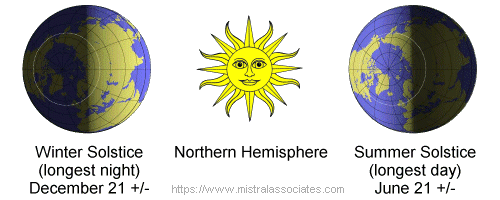Either of the two points (and thus by definition also the times) at which the sun reaches its greatest declination north or south. Each solstice is upon the ecliptic (the projection of the Earth’s orbit on the celestial sphere) midway between the equinoxes and, therefore, 90º from each other. The solstice occurs around the 21st of June and the 21st December. In the northern hemisphere therefore June 21st represents the day of the year upon which the sun is visible in the sky for more time than any other day and the 21st December the day upon which the sun is visible for the least time (the ‘longest’ and ‘shortest’ days respectively). In the southern hemisphere the reverse is true.

The solstice is used by the program only as a quick guide to ‘worst case’ examples of maximum and minimum loads likely to be experienced in a structure. The rule cannot be definitive however as many other factors will effect peak and trough weather conditions such as local seasonal wind patterns (monsoons for example) and ocean currents (The Gulf Stream for example).
Please be aware that individual buildings will also exhibit different energy gain and loss profiles due to differences in such features as fenestration and orientation. For example, a building with a considerable amount of glass on a west facing wall may experience its highest gains from solar radiation rather later in the day than a similar building with reversed orientation (most glass in the east wall). A building with the same amount of glass in a south facing wall and none in its west wall may receive less solar radiation than a building with an identical amount of glass in a west facing wall but with none in its south wall. This is because the sun’s declination is higher when its azimuth is due south than when its azimuth is due west.